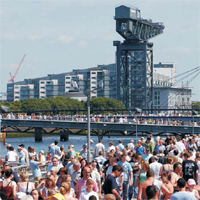Waterways and Development of the Territory: New Mobility and Sustainable Tourism
Abstract
In most cases origin of first urban settlements, waterways have been the main source for human life and the tool for the exchange of goods and cultures. Thanks for their crossing the territory, they have always been places of intersection of different aspects of the urban life bringing together environment, planning, architecture, transport but also art, culture, education and tourism. Due to this aspect, waterways have a great potentiality for the development of a territory with regard to both, mobility – of people and goods – and sustainable tourism. Their regeneration allows to recover a role of public space as rural, urban and tourism landscape of great quality; at the same time, as places for tourism, cultural, gastronomic and leisure uses, they generally induce quality of life. After decades of neglect and indifference, a renewed interest toward the valorization of waterways for culture and tourism is emerging in Italy – particularly in the Nord part of the Country – encouraged also by European directives. Even if with a delay comparing to other European Countries that, since many years, are developing different ways of using waterways, Italy is now showing a new sensibility and approach to look at waterways as an important tool for environmentally sustainable development and to reconnect with a forgotten cultural identity. A selection of projects and initiatives are presented, mostly devoted to the re-launch of water transport for leisure activities and to the rediscover of waterways with a ‘slow’ and ‘soft’ approach. The valorization of architecture, nature and local culture and the proposal of alternative itineraries combining different modalities of transportation are the core of North Italian proposals along the rivers Po, Mincio, Adda, Piave, Limena and the canals network of the Venice lagoon. In particular, the project referred to the Po river, includes the navigation for leisure from Locarno, Switzerland, to Venice, through Milan and the Navigli network. This spectacular trip, every two years realized as a demonstration by the promoting bodies, could be a mid-term goal – at least for part of its length – in view of the Milan Expo 2015: an alternative way of transportation and connection and a tool for the discovery of a less known cultural heritage. Furthermore, the Piave river, in the past main way of communication and witness of many event of the First World War, needs now serious interventions to become more accessible and to be protected from energy production uses. Thanks to the applications of innovative technologies and of new sources of energy, waterways can also act as the best laboratory for sustainable development, at urban and environmental scale. Waterways can represents the chance for a new understanding of urban and natural landscape, in the balance between safeguard and innovation.Downloads
References
Breen A., Rigby D., “The new waterfront. A worldwide urban succes story”, Thames and Hudson, 1996.
Bruttomesso R., “Città d’acqua”, in Abitare N.417, Editrice Abitare Segesta, Milano, 2002.
Bruttomesso R. (a cura di), “Città-Porto/City-Port”, Catalogo della 10. Mostra Internazionale di Architettura di Venezia, Marsilio Editore, Venezia, 2006.
Censi B., Pittalis G. N., Favaro M., “Il Portolano delle Vie d’Acqua del Nord Itali”, Mazzanti Editore, 2008.
ICPDR - International Commission for the Protection of the Danube River, “Manual on Good Practices in Sustainable Waterway Planning”, PLATINA, 2010.
Farinella R. (a cura di), “I fiumi come infrastrutture Culturali”, Editrice Compositori, 2005.
Giovinazzi O. (a cura di), “Città portuali e waterfront urbani. Ricerca bibliografica”, Edizioni Città d’Acqua, Venezia, 2007.
Giulio C., “Il collegamento Reno-Meno-Danubio e le idrovie padano venete nel sistema dei trasporti europei”, Laveglia Editore, 2010.
Istituto per i Navigli/Associazione Amici dei Navigli (a cura di), “In Viaggio sui Navigli. Il Naviglio pavese da Milano al Ticino”, Skira Editore, 2001.
Marshall R., Waterfront in post-industrial cities, Spon Press, New York, 2001.
Marzo Magno Alessandro, “Piave. Cronache di un fiume sacro”, Il Saggiatore, 2010.
Montag Stiftung Urbane Raüme and Regionale 2010 (eds.), Christoph Hölzer, Tobias Hundt, Caroline Lüke, Oliver G. Hamm, Riverscapes. Designing Urban Embankments, Cologne/Bonn Good Regional Practice, Birkhäuser, 2008.
Negri G. (a cura di), “Le vie d’acqua: rogge, navigli, canali”, Milano, Electa, 2000.
Pizzo B., Di Salvo G. (a cura di), “Terres de Rivières”, Officina Edizioni, 2006.
Prevel A., “Paysage urbain, à la recherche d’une identité des lieux”, Ministère des Transports de l’Équipement du Tourisme et de la Mer, Lyon, CERTU, 2006.

Copyright (c) 2014 Tema. Journal of Land Use, Mobility and Environment

This work is licensed under a Creative Commons Attribution 4.0 International License.
Authors who publish in this journal agree to the following:
1. Authors retain the rights to their work and give in to the journal the right of first publication of the work simultaneously licensed under a Creative Commons License - Attribution that allows others to share the work indicating the authorship and the initial publication in this journal.
2. Authors can adhere to other agreements of non-exclusive license for the distribution of the published version of the work (ex. To deposit it in an institutional repository or to publish it in a monography), provided to indicate that the document was first published in this journal.
3. Authors can distribute their work online (ex. In institutional repositories or in their website) prior to and during the submission process, as it can lead to productive exchanges and it can increase the quotations of the published work (See The Effect of Open Access)
